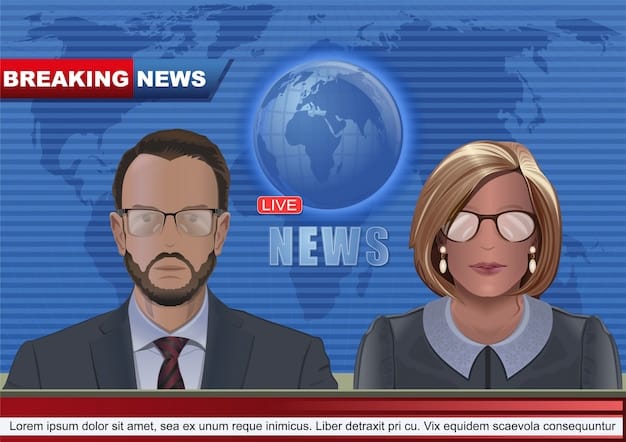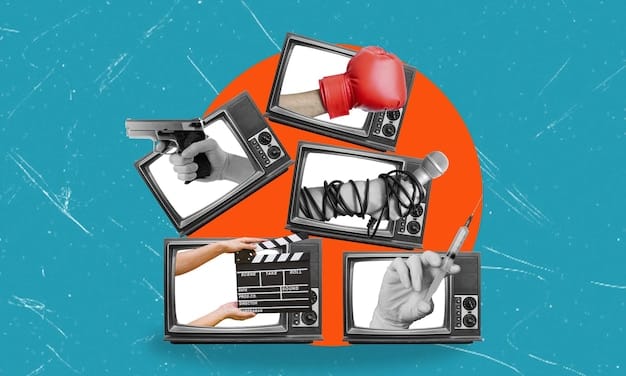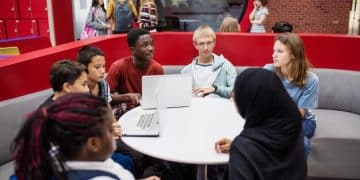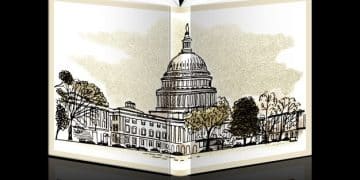Analyzing Media Bias Impact on Public Policy Perception

Analyzing the impact of media bias on public perception of public policy debates reveals how skewed reporting can significantly shape public opinion and understanding of critical issues.
The way media presents information can greatly influence what people think about important public policies. This article delves into analyzing the impact of media bias on public perception of public policy debates, exploring how different types of biases affect citizens’ understanding and opinions in the United States.
Understanding Media Bias in Public Policy Reporting
Media bias in the realm of public policy isn’t always about outright falsehoods. It often manifests in subtle ways, influencing the narrative and shaping public opinion. Recognizing these biases is crucial for informed civic engagement.
Media outlets, whether intentionally or unintentionally, can exhibit bias through various mechanisms. These include selecting specific stories, framing issues in a particular light, and giving certain voices more prominence than others. Understanding these mechanisms is key to critically evaluating the information presented.
Types of Media Bias
Several types of media bias can affect how public policy debates are perceived.
- Selection Bias: The choice of which stories to cover and which to ignore. This can create a skewed perception of the frequency and importance of certain issues.
- Framing Bias: The way a story is presented, including the language used and the angle emphasized. This can influence how the audience interprets the information.
- Placement Bias: Where a story is placed in a newspaper or broadcast. Stories in prominent positions are perceived as more important.
- Source Bias: Relying heavily on sources with a particular viewpoint. This can lead to a one-sided representation of an issue.
These biases can collectively shape the narrative surrounding public policies, affecting how the public understands and responds to them. Recognizing these biases is the first step in promoting media literacy and critical thinking.

The Psychological Impact of Biased Reporting
The psychological effects of biased reporting extend beyond simply influencing opinions. It can also affect cognitive processes, emotional responses, and ultimately, behavior. Understanding these psychological mechanisms is vital for comprehending the full impact of media bias.
Exposure to biased information can trigger confirmation bias, where individuals seek out and interpret information that confirms their existing beliefs. This creates echo chambers where opposing viewpoints are rarely encountered, reinforcing existing biases and polarizing opinions further.
Cognitive and Emotional Responses
The way information is framed can evoke different emotional responses, influencing how individuals process and remember the information.
- Emotional Framing: Using emotionally charged language or imagery to manipulate the audience’s feelings.
- Cognitive Dissonance: Experiencing discomfort when confronted with information that contradicts existing beliefs, leading to selective exposure and rationalization.
- Anchoring Bias: Over-relying on the first piece of information received, even if it’s biased or inaccurate.
By understanding these psychological mechanisms, individuals can become more aware of how media bias is affecting their own thinking and decision-making processes. This awareness can empower them to seek out diverse perspectives and engage in more critical evaluation of the information they encounter.
Case Studies: Media Influence on Policy Perception
Examining specific case studies reveals the tangible impact of media bias on public perception of key policy issues. These examples demonstrate how biased reporting can shape public discourse and influence policy outcomes.
Consider the reporting on climate change. Some media outlets frame it as an urgent crisis requiring immediate action, while others downplay its severity or question its scientific basis. This conflicting messaging can lead to public confusion and skepticism, hindering efforts to address the issue.

Examples of Policy Issues Affected
Here are examples of issues that are highly vulnerable to media bias.
- Healthcare Reform: Coverage often focuses on polarizing aspects, such as costs and government involvement, while neglecting potential benefits and alternative perspectives.
- Immigration Policy: Framing can range from emphasizing security concerns to highlighting the economic contributions of immigrants, shaping public attitudes towards different immigration policies.
- Gun Control: Media coverage often focuses on specific incidents, such as mass shootings, without providing comprehensive analysis of the complex factors involved and alternative solutions.
These case studies illustrate how media bias can distort public understanding of complex policy issues, making it difficult for citizens to form informed opinions and engage in constructive dialogue.
Counteracting Media Bias: Strategies for Critical Consumption
Combating the effects of media bias requires a multi-faceted approach, emphasizing media literacy, critical thinking skills, and diverse information sources. By actively engaging with information and challenging biased narratives, individuals can become more informed and empowered citizens.
It starts with recognizing your own biases and actively seeking out perspectives that challenge them. This can involve reading news from different sources, engaging in conversations with people who hold different views, and critically evaluating the information you encounter.
Developing Media Literacy Skills
Media literacy is the ability to access, analyze, evaluate, and create media. It empowers individuals to become more discerning consumers of information.
Here are steps for improving your media literacy.
- Identify the Source: Determine the credibility and potential biases of the source. Is it a reputable news organization or a partisan website?
- Analyze the Framing: Pay attention to the language used and the angle emphasized. Is the story presented in a balanced and objective manner, or is it designed to evoke a particular emotional response?
- Seek Diverse Perspectives: Read news from different sources and engage in conversations with people who hold different views. This will help you gain a more comprehensive understanding of the issue.
By actively practicing these strategies, individuals can develop their media literacy skills and become more resistant to the effects of media bias.
The Role of Social Media in Amplifying Bias
Social media platforms have become powerful amplifiers of media bias, creating echo chambers and spreading misinformation rapidly. Understanding how social media algorithms and user behavior contribute to this phenomenon is crucial for mitigating its negative effects.
Social media algorithms are designed to show users content that they are likely to engage with, based on their past behavior and preferences. This can lead to filter bubbles, where individuals are primarily exposed to information that confirms their existing beliefs, reinforcing biases and limiting exposure to diverse perspectives.
Addressing Social Media’s Impact
There are things that can be done to counter this effect:
- Algorithm Awareness: Understanding how algorithms work and how they can create filter bubbles.
- Diversifying Sources: Actively seeking out diverse perspectives and challenging echo chambers.
- Fact-Checking: Verifying information before sharing or believing it.
By promoting critical thinking and media literacy on social media platforms, individuals can help to counter the spread of misinformation and reduce the amplification of media bias.
The Future of Media and Public Policy Perception
The media landscape is constantly evolving, with new technologies and platforms emerging all the time. This presents both challenges and opportunities for shaping public policy perception.
Artificial intelligence (AI) is playing an increasingly important role in the creation and dissemination of news. AI-powered algorithms can be used to generate news articles, personalize content recommendations, and detect misinformation. However, AI can also be used to create deepfakes and spread propaganda, posing new challenges for media literacy and critical thinking.
Looking Ahead
How can we face the future of media and policy?
- Enhanced Media Literacy Education: Equipping individuals with the skills to critically evaluate information in a rapidly evolving media landscape.
- Transparent AI Algorithms: Ensuring that AI algorithms used in news creation and dissemination are transparent and accountable.
- Collaborative Fact-Checking Initiatives: Supporting collaborative efforts to combat misinformation and promote accurate reporting.
By addressing these challenges and embracing new opportunities, we can work towards a future where the media plays a more constructive role in shaping public policy perception.
| Key Point | Brief Description |
|---|---|
| 📢 Media Bias Types | Selection, framing, source biases can skew policy views. |
| 🧠 Psychological Impact | Biased reporting affects cognition, emotions, and behavior. |
| 📱 Social Media Role | Algorithms amplify bias, creating echo chambers. |
| 📚 Media Literacy | Critical consumption skills can counteract media bias effects. |
Frequently Asked Questions (FAQ)
▼
Common examples include selection bias (choosing which stories to cover), framing bias (presenting a story in a particular light), and source bias (relying on sources with a specific viewpoint).
▼
Social media algorithms can create filter bubbles, where users are primarily exposed to information that confirms their existing beliefs, reinforcing biases and limiting exposure to diverse perspectives.
▼
Strategies include developing media literacy skills, seeking diverse perspectives, verifying information before sharing it, and being aware of your own biases.
▼
Emotional framing uses emotionally charged language or imagery to manipulate the audience’s feelings, influencing how they process and remember the information.
▼
Media literacy empowers individuals to become more discerning consumers of information, enabling them to critically evaluate sources, identify biases, and make informed decisions.
Conclusion
Analyzing the impact of media bias reveals its significant influence on public perception of public policy debates. By understanding the types and psychological effects of bias, developing media literacy skills, and seeking diverse perspectives, individuals can become more informed and empowered citizens. It’s crucial to fostering a healthy democracy where public policies are debated and evaluated based on facts and evidence, rather than skewed narratives.





